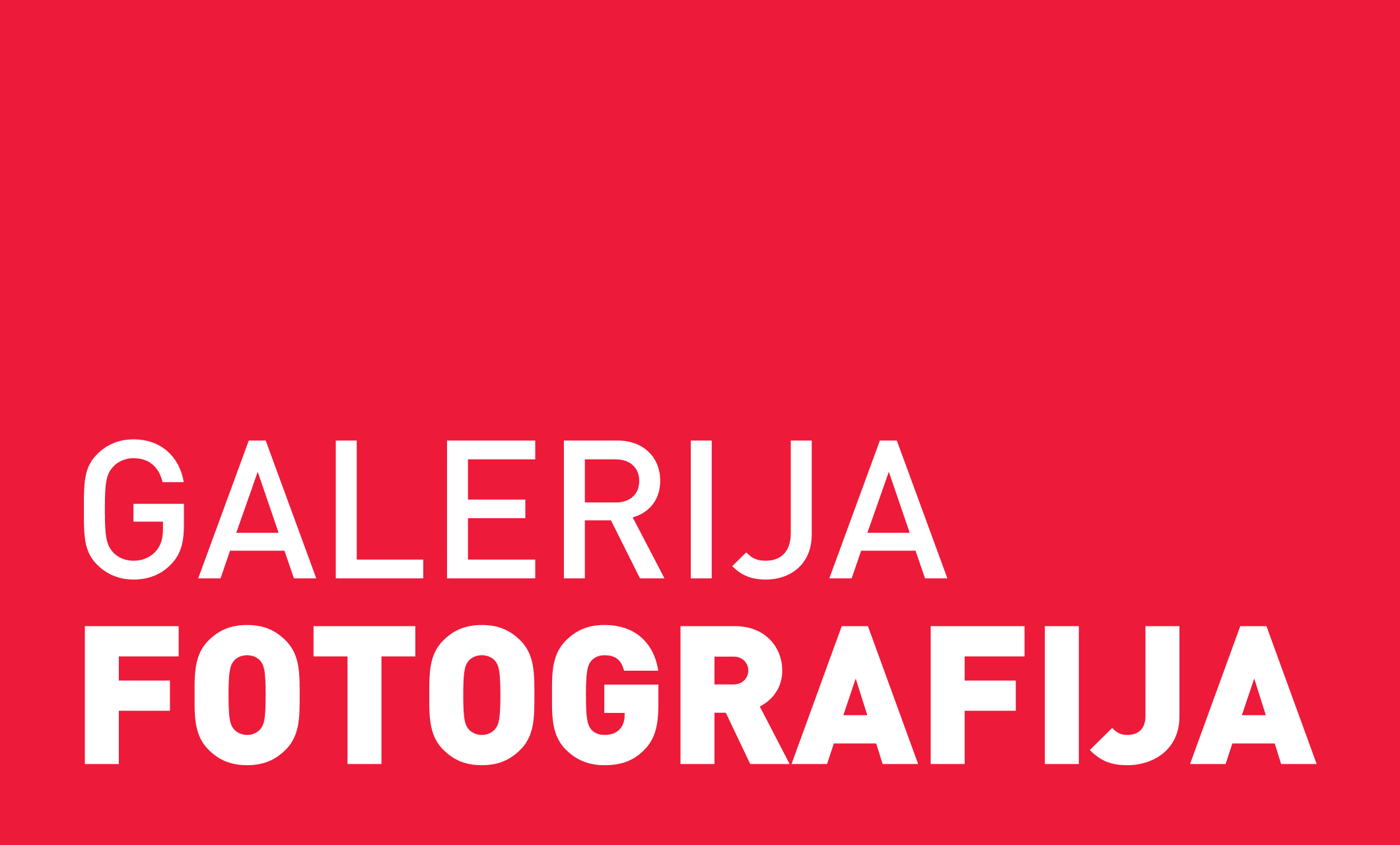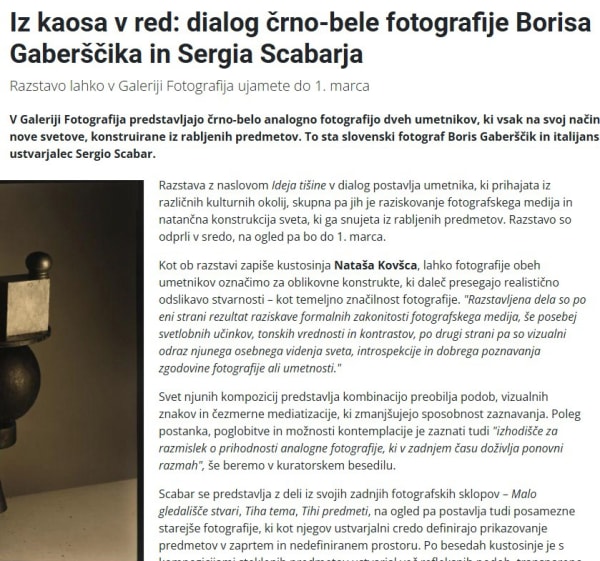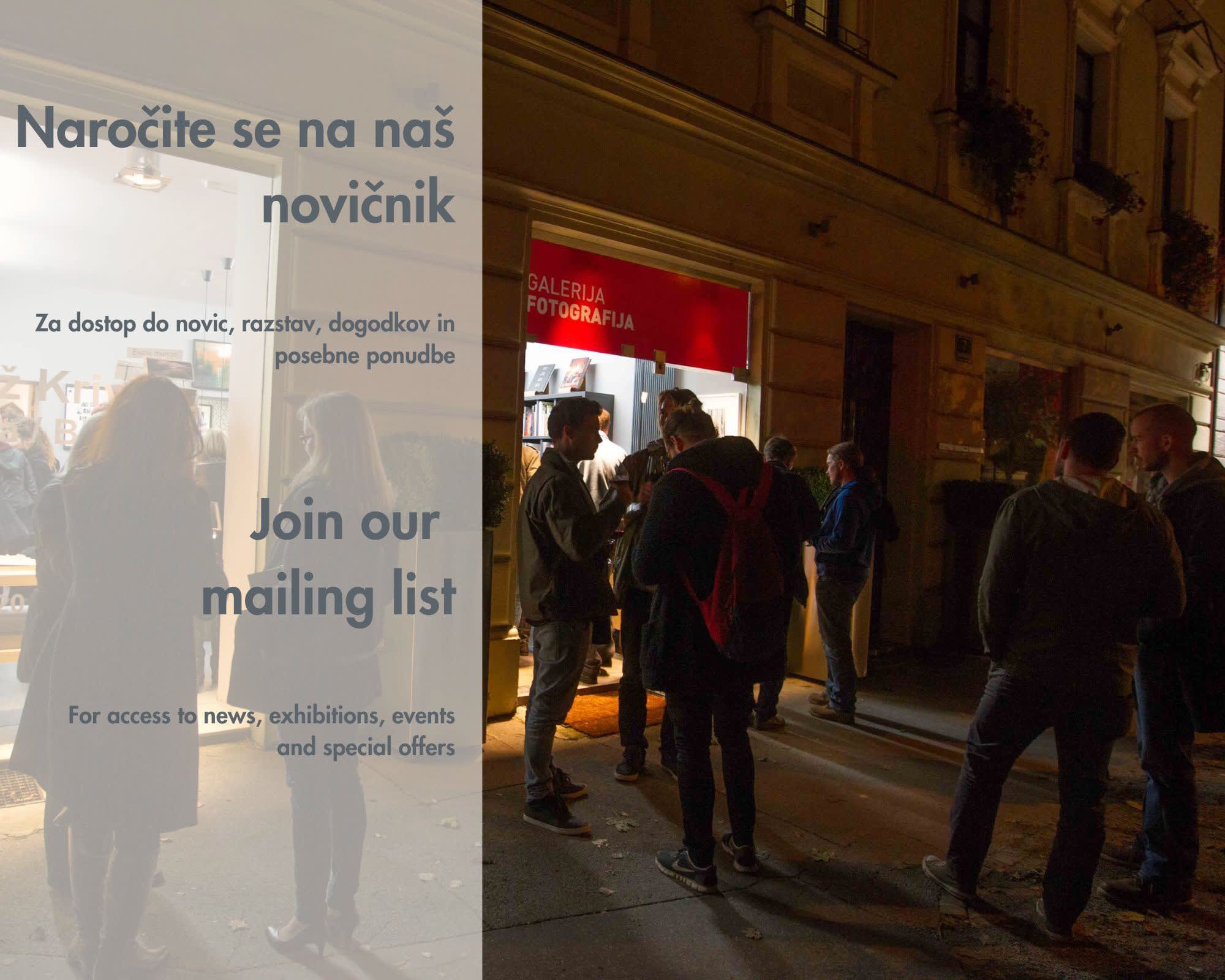The exhibition entitled The Idea of Silence brings into dialogue the works of two masters of black and white analogue photography: the Slovenian photographer Boris Gaberščik and the Italian artist Sergio Scabar. The two artists come from different cultural backgrounds, but their work is united by a creative approach based on the exploratory nature of the photographic medium and the creation of meticulously thought-out compositions made exclusively from used objects.
The creative paths of Boris Gaberščik and Sergio Scabar also have completely different formal and stylistic starting points. Scabar’s early photographic series from the 1970s and the first half of the 1980s were strongly influenced by conceptual photography, and he also dabbled in reportage. As his retrospective exhibition at the Gorizia Regional Museums showed,
[1] the thematic turn in his work – from depicting the outside world to photographing everyday objects – took place gradually after 1986. Since the 1980s, however, Boris Gaberščik has always studied the microcosm of objects – the only exceptions are the individual series of landscape images, which are deliberately blurred and refer more to his imaginings than to the visible world.
[2]
Gaberščik’s still lifes are sophisticated compositional studies that explore, in particular, the spatial relationships between objects and the lighting effects between illuminated bodies and their shadows. In his visual approach, on the one hand, there are clearly identifiable references to the history of photography, in particular modernist photographic production and the works of those artists who used everyday objects to create a new reality based on artistic principles.
[3] On the other hand, his depictions are completely imbued with symbolic meanings. For example, for the photographs in the
Solve et Coagula series,
[4] Gaberščik found inspiration in alchemical teachings and processes, which in fact represent a kind of parallel to his photographic work: Gaberščik, too, ennobles discarded objects with an idea and a new meaning. Out of chaos he creates order, which is a reflection of his personal thoughts and views on life and the world, as can be clearly seen in his latest photographic series
Origin,
Order and
Theatrum Chemicum.
The works in the
Origin series refer to the creation of the world, one of the fundamental motifs of Christian natural science. However, the series of seven images does not follow a biblical literary source but represents the artist’s original interpretation of the creation events, among which two works are particularly noteworthy: the opening photograph depicting the idea of the creation of the world/new beginning, and the last image illustrating the invention of the machine.
[5] The series of associative images is, of course, also linked in terms of form, as the selected objects – mostly glass lenses – are assembled into complex structures and illuminated with precisely directed artificial light, which creates a mystical atmosphere with a multitude of shadowy images and reflections, emphasising the surreality of events that are incomprehensible to humans.
The photographs in the second set focus on the creation of visual order, which in Gaberščik’s personal expression marks a retreat into an inner, intimate world.
[6] The harmonious compositions of carefully selected objects actually express the essence of his creative process, which involves the study of the rhythm of repetitive forms and the precise arrangement of light and tonal values, reflections and transparencies. Light is the element in his photographs that breathes life into static compositions. In fact, the soft, unified light seems to completely permeate the objects, while at the same time revealing the traces of time – the marks of the objects’ use, their “wounds”, as the artist puts it, which also create picturesque textures on the grounds and backgrounds.
In his last series, entitled
Theatrum Chemicum[7], Gaberščik once again highlights the analogy between photography and alchemy: it is revealed both in the selection of laboratory objects placed in delicate balances and in the process of making photographs according to the classical analogue process, using selenium toner, which, in combination with the long exposure times, gives his photographs an air of a kind of ethereality, timelessness.
Timelessness also characterises the works of Sergio Scabar, who used a specific photographic technique to create unique, inimitable images.
[8] The distinctive feature of his work, which mostly depicts objects from his own “cabinet of wonders” and still lifes of “hidden life”,
[9] is a distinctly dark tonal scale, which creates an unusually quiet atmosphere in the photographs. On the other hand, the black frames that are an integral part of the images give the works a mark of uniqueness, testifying to Scabar’s conception of photography as an object in the context of the conceptual approaches of the 1970s.
[10]
The present exhibition presents a selection of works from Scabar’s recent photographic series
Little Theatre of Things (
Teatrino di cose, 2016),
Silent Darkness (
Oscurita silente, 2017),
Silent Objects (
Oggetti silenti, 2018), as well as individual older photographs, which clearly define his creative credo: the representation of objects in a closed, undefined space, which transcends the reflection of reality and crosses over into another reality/illusionistic space. The light in all the photographs is weak, muted, uniform and creates barely noticeable, undefined shadows. Scabar – unlike Gaberščik – worked in daylight, and the atmosphere in the photographs, which (also) resembles more a painting due to the chiaroscuro effects,
[11] was created with his “alchemistic” technique.
The selected works show Scabar’s characteristic motifs, such as compositions of glass objects, in which he explored in particular the relationship between overlapping translucent materials and light, creating a multitude of reflective images, transparencies, soft reflections and shadows. At the same time, dust particles can be seen on the objects, which – like the traces of wear and tear – mark the passage of time. In other photographs, he has immortalised the natural forms of seashells, both their subtle outer texture and their inner structure and contour lines – shapes that reflect the ubiquitous order in nature, the beauty of natural forms. The same applies to the minimalist compositions with a single object, which draw our attention not only through the thoughtful lighting of the motifs, but also through the perfect balance between (geometric) form and space. Of course, the motifs in Scabar’s photographs can also be associated with symbolic meanings, for example the image of an egg signifies birth/new beginnings. The selection of subject matter often also relates to Scabar’s own creative process and the photographic medium in general,
[12] but the images are by no means singular, but allow for different readings. Above all, they touch us with a specific poetry and an almost metaphysical atmosphere.
The photographs of Sergio Scabar and Boris Gaberščik can be characterised as formal constructs that go far beyond the realistic reflection of reality – as a fundamental characteristic of photography. The works on display are, on the one hand, the result of an investigation into the formal laws of the photographic medium, in particular lighting effects, tonal values and contrasts, and on the other hand, a visual reflection of their personal vision of the world, their introspection and their intimate knowledge of the history of photography/art. The works are also linked by the perfection of their technical execution and by the meaning of the still life, according to photography theorist David Bate, a minor genre in the history of photography. The silent world of their compositions, devoid of grand narratives and twists, is in fact a kind of counterpoint to the overabundance of images, visual signs and excessive mediatisation that diminish the depth of our perception. Gaberščik’s and Scabar’s works offer everything that we miss in our everyday life, which is permeated by a constant flow of information: a pause, a deepening and a possibility of contemplation. At the same time, they are a starting point for reflection on the future of analogue photography, which has recently experienced a resurgence.
Nataša Kovšca
[1] The retrospective exhibition at the Attems Petzenstein Palace (2019) also presented Scabar’s early work, which has been less well known to the public.
[2] It should be noted that Boris Gaberščik has also photographed the paintings and sculptures of numerous Slovenian artists for publication in exhibition catalogues and monographs.
[3] In his oeuvre, he has not only paid tribute to a number of great photographers, such as Man Ray, Josef Sudek, Edward Weston, Walter Peterhans, etc., but also to individual masters of painting, such as Giorgio Morandi, as well as to writers and inventors.
[4] In 2018, he received the Prešeren Fund Prize for his photographic series Solve et Coagula and Von Dieser Welt.
[5] The depiction of the idea is followed by images of the creation of the planets, the separation of light and dark, the appearance of the first cell, the division of the cell, the origin of life and the invention of the machine.
[6] The works can be linked in particular to the exhibition Ordo ab Chao (2006), named after an old Masonic saying meaning 'order over chaos'.
[7] The most complete collection of alchemical writings and treatises from the 17th century.
[8] Guido Cecere and Angela Madesani describe the technique as “alchemical”, as he has adapted the recipe for making the photographs to the desired effect.
[9] Scabar’s oeuvre includes, for example, a series of still lifes titled Little Vegetative Theatre (Teatrino vegetale, 2016).
[10] This is evident in his earlier cycles from the 1980s, such as Tarpaulin (Telone) or Movements (Spiazzamenti).
[11] Scabar, in addition to Josef Sudek’s photographs, also greatly appreciated Giorgio Morandi’s paintings.
[12] For example, there is a photograph of a container with paint and brushes for painting frames. He also dedicated one of his series Objects of Photography (Oggetti della fotografia, 2012) to photographic objects and materials.





